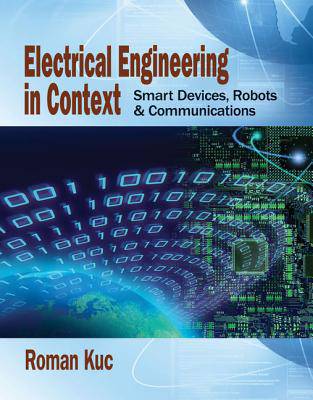
Bedankt voor het vertrouwen het afgelopen jaar! Om jou te bedanken bieden we GRATIS verzending (in België) aan op alles gedurende de hele maand januari.
- Afhalen na 1 uur in een winkel met voorraad
- In januari gratis thuislevering in België
- Ruim aanbod met 7 miljoen producten
Bedankt voor het vertrouwen het afgelopen jaar! Om jou te bedanken bieden we GRATIS verzending (in België) aan op alles gedurende de hele maand januari.
- Afhalen na 1 uur in een winkel met voorraad
- In januari gratis thuislevering in België
- Ruim aanbod met 7 miljoen producten
Zoeken
€ 272,45
+ 544 punten
Omschrijving
ELECTRICAL ENGINEERING IN CONTEXT: SMART DEVICES, ROBOTS & COMMUNICATIONS by bestselling author Roman Kuc describes the basic components and technologies that make today's computer-assisted systems operate and cooperate, inviting the reader to understand by participating in the design process. Directed at the undergraduate electrical engineering student, this book starts with the basics and requires a working knowledge of algebra. Rather than simple plug-and-chug exercises, the book teaches sophisticated problem-solving and design tools. Students will learn through designing digital displays, extracting information from signals, and optimizing system performance through parameter value selection and observing graphical data displays. Animations showing dynamic system behavior and relating to the book figures are available through the book's companion site. At the completion of the course, students will have an understanding of the capabilities of current digital devices and ideas for possible new applications. This will benefit students in other courses requiring quantitative skills and in their profession. To help accomplish this tall order, the book is written in a graduated intensity that can be adapted to the specific needs and talents of each student: Basic commands and graphs are used in first-level problems that illustrate device performance while varying parameter values and in designs that are open-ended, driven by student curiosity. Some problems can be solved using software packages, but many exercises are for paper and pencil solution. MATLAB based examples and problems are also included for users comfortable with computer programming.
Specificaties
Betrokkenen
- Auteur(s):
- Uitgeverij:
Inhoud
- Aantal bladzijden:
- 608
- Taal:
- Engels
- Reeks:
Eigenschappen
- Productcode (EAN):
- 9781285179186
- Verschijningsdatum:
- 6/03/2014
- Uitvoering:
- Hardcover
- Formaat:
- Genaaid
- Afmetingen:
- 221 mm x 277 mm
- Gewicht:
- 1224 g

Alleen bij Standaard Boekhandel
+ 544 punten op je klantenkaart van Standaard Boekhandel
Beoordelingen
We publiceren alleen reviews die voldoen aan de voorwaarden voor reviews. Bekijk onze voorwaarden voor reviews.









